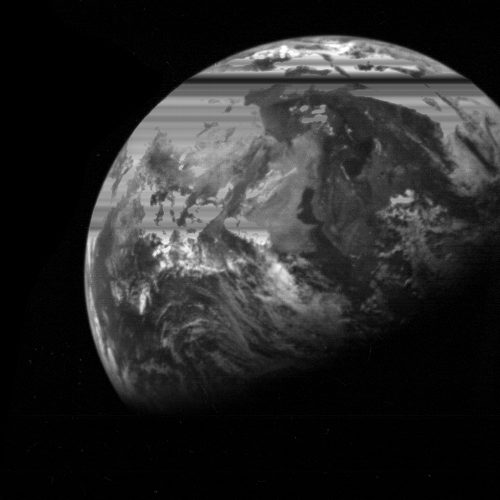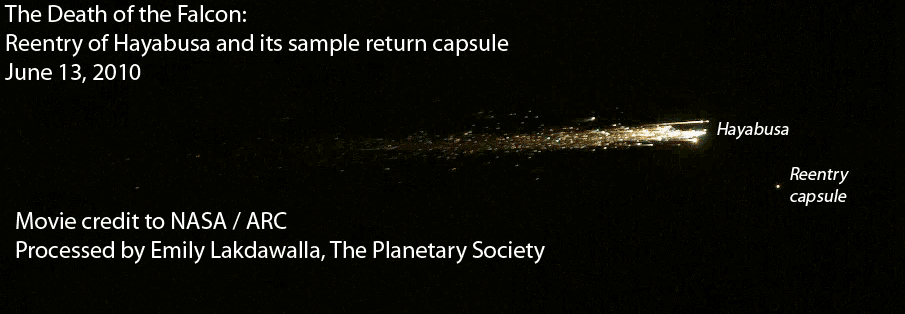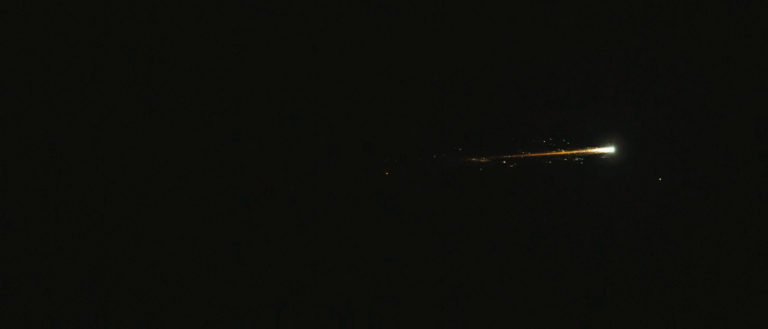Emily Lakdawalla • Jun 13, 2010
Hayabusa's return: a review
So it's been six hours now since the Hayabusa spacecraft ended its journey in a brilliant flash of light in the dark sky of southern Australia. It was a moment both triumphant and sad. It was literally triumphant because that's what it represented, the triumph of human ingenuity to overcome seemingly impossible challenges that befell the mission time and again. But sad, too, because as we back on Earth followed those trials, we couldn't help but imbue the spacecraft with personality, especially a will to overcome adversity.
As I write this, the capsule's location has been tagged, but it has not yet been retrieved. The heat shield, which fell separately from the capsule, has not yet been found, but they say they will search again in daylight. This post is just to round up some of the amazing photos, movies, and artworks that were posted and shared and Tweeted and re-Tweeted over the previous dozen hours or so.
Before I post the videos of Hayabusa's death, I have one special image: the last photo captured by Hayabusa itself. This was taken after the capsule had been released, and shows Earth looming in Hayabusa's forward view. I'm posting both the original version as returned from the spacecraft, and one produced by Gordan Ugarkovic. The streaking is caused by the brightness of Earth's clouds saturating the camera detector.


OK, on to the reentry images. One of the most spectacular views of the reentry came from NASA's DC-8 airplane that was flown to Australia as part of the Hayabusa Re-entry Airborne Observing Campaign. Here is my own version of the movie, an animated GIF representing one frame per second (sped up 10x); I steadied the frames by aligning them on the reentry capsule, and adjusted the levels to bring out more details in the fireballs. Following my version are some stills and the full video from Youtube. You can download the original video here (42 MB, Quicktime format).

Here's a selected still.
But you really have to watch the full video to see the dynamics of the breakup; it's mesmerizing.
And apparently, that's not the end of it; a higher resolution version is supposed to be available at the Hayabusa Re-entry Airborne Observing Campaign website later today.
You want more? I've got more: the next ones are shot from the ground. There was a nice description of the eyewitness experience of observer Robin Whittle here: "I can't estimate the magnitude but at its peak it was much brighter than Venus. The whole sighting was (I guess) 20 to 30 seconds. After the peak brightness the brightest object left a shimmering trail and for quite a few seconds a smaller, more pin-point, orange object was slightly ahead of it and slightly lower. Later, the orange object dimmed and continued after the main object, which was blue-white, faded. I have a picture 1/15 sec hand-held, but it doesn't show the clarity we could see by eye, with the two separate objects, with the precious payload returning to Earth, just as planned."
Here is a Japan Broadcasting Corporation news report with video shot from the ground.
Here's a nice still from a similar point of view:
...and one taken with an all-sky camera. You can really fall into the Milky Way in this one.

And now for the fun stuff: a collection of the whimsical artwork and costumes of Japanese artists, TV hosts, and cosplayers, gleaned from various sources. Clearly the story of Hayabusa resonated with the Japanese public, because this is just the tip of the iceberg. I wonder what young engineers the mission will inspire, and if Japanese space exploration will get a boost from the enthusiasm generated by Hayabusa's success? We can only hope!

Let’s Go Beyond The Horizon
Every success in space exploration is the result of the community of space enthusiasts, like you, who believe it is important. You can help usher in the next great era of space exploration with your gift today.
Donate Today

 Explore Worlds
Explore Worlds Find Life
Find Life Defend Earth
Defend Earth


